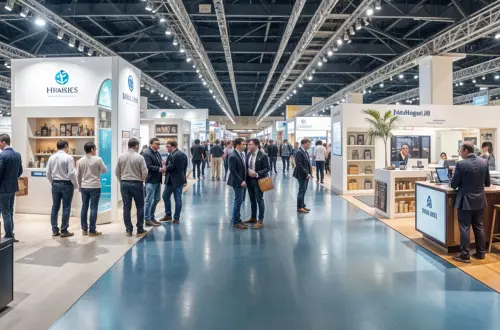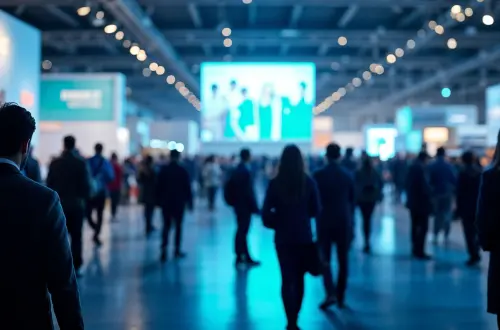LogiMAT 2022 – “Smart – Sustainable – Safe” Restart Edition Greatly Exceeds Expectations
LogiMAT 2022 exceeded the expectations of organisers and participants. The restart live edition took place in Messe Stuttgart. It was held between 31.05.2022 and 02.06.2022 under the maxim “Smart – Sustainable – Safe.” A total of 1,571 exhibitors from 39 countries and 50,000 trade visitors attended the event. LogiMAT 2022 also served as the debut stage for many innovations. It was furthermore the award ceremony location of the BEST PRODUCT Award 2022. The absence of strict Covid-19 safety regulations contributed to the jubilant atmosphere. The event received high attendance numbers, especially when considering the pandemic.
Messe Stuttgart once again served as the hosting location for LogiMAT. The venue did not feature stringent Covid-19 safety measures. This was among the chief contributors to the jubilant atmosphere. It enabled attendees to engage in an environment as close to normal as possible. Organisers advised participants to follow recommendations such as wearing an FFP2 mask. When achievable, they were encouraged to uphold a safe distance of 1.5 metres. They were also advised to observe the general hygiene rules. Such included performing frequent hand sanitation.
The central theme of LogiMAT 2022 was “Smart – Sustainable – Safe”. The key theme was reflected throughout the support programme. One method of displaying included the high number of presented innovations. The central theme furthermore was reflected in the Expert Forums. They showed this via lectures, such as “The future of adaptable logistics”. The BEST PRODUCT Award also reflected the theme. It accomplished this via its appointed winners.
Among the lead highlights were the 14 Expert Forums. They took place at LogiMAT Arena. The Arena was located close to the East Entrance of Messe Stuttgart. The Forums featured live presentations that discussed pending topics. Each featured a lead expert in business and academic communities as the speaker. They also featured industry press members as participants. The Forums enabled intralogistics strategists and practitioners to gain insights into various aspects. The highlights of the Expert Forums were the sessions:
|
|
One of the lead highlights was the presentation and award ceremony of the BEST PRODUCT Award on 31.05.2022. It granted recognition to companies whose innovations have significantly contributed to the industry. This included augmenting processes, reducing costs, and enhancing productivity. The Award features three categories:
- IT, Communication, Software
- Storage Technology, Lifting, Conveying, Order Picking
- Load Securing, Identification, Packaging and Loading Technology
The 2022 winners of the BEST PRODUCT Award include an adaptable AMR. They also feature an intralogistics management platform that can synchronise entire vehicle fleets. They furthermore introduced a high-quality pallet classification system. An independent jury selected the winners from over 100 submissions. The award presenter was Prof. Johannes Fottner.
The winner of the Order Picking category is Bosch Rexroth AG. They received recognition for their ActiveShuttle autonomous mobile robot (AMR). Their AMR has the adaptive skill to select and lift warehouse dollies loaded with totes. It can also transport them reliably to their appointed destination. Additionally, the integrated safety systems enable the AMR to stop precisely when needed. It furthermore can safely bypass obstacles. A safety laser scanner combined with stereo cameras to create a 3D scan of the area achieves this. This, in turn, allows the robot to detect even protruding objects that can pose a trip hazard. The AMR can continuously operate and has a speed of 1 metre per second with a loading capacity of 260 kg. The product additionally can serve as the central command centre for the fleet. This is due to specialised software displaying a real-time status to the whole fleet. It furthermore can assign pending transport orders to vehicles. It also promotes the control and configuration of logistics planning scenarios. This enables high flexibility when handling order management. This applies the most when orders are entered manually or via third-party software. On-site efficiency is also improved due to the integrated-into-the-vehicle-console touchscreen display. As a result, the transparency, diagnostics momentum, and onboarding process speed are enhanced.
SICK Vertriebs-GmbH is the “Identification” category winner for their PACS pallet classification system. It identifies the type using the branding found on the feet of the pallet. It then assigns the pallet a class using a trained deep-learning neural network. The designated category enables the automatic designation of the deposit. The system is compact and can be integrated into logistics chains without difficulty. It is also suitable for tight spaces due to its modular design. The design features a blend of software and hardware components. The image recording can occur via one or more colour cameras. Using standard hardware with the product is possible. This is due to the SICK AppSpace and dStudio software. SICK AppSpace enables on-site solution tailoring based on customer needs. Previous knowledge of programming or machine learning is unnecessary. This is due to the intuitive user interfaces. Users can also expand the system range using sensors that scan barcodes and perform other tasks.
The Startup company SYNAOS GmbH won in the “Software” category. They received recognition for their SYNA.OS LOGISTICS. This is an AI-and-cloud-technology-using intralogistics management platform. The software uses real-time data to synchronise vehicles, mobile robots and forklifts. The software additionally can perform the instantaneous optimisation of processes using AI-based algorithms. Such include asset control, storage management, vehicle localisation and vehicle & operator management. The platform completes the tasks using cloud computing. This allows it to sort through possibilities and select the most optimal solution. The novel software furthermore reduces the complexity of intralogistics disorder. In particular, the type caused by autonomous machines created by different hardware manufacturers. This is due to the platform using the VDA/VDMA standard, known as VDA 5050, to integrate all vehicles in real-time. This enables the software to convert an incongruous group into an effective fleet. The scalability is set to accommodate up to 1,000 automobiles. SYNA.OS LOGISTICS additionally responds immediately to malfunctions and operating errors. This reduces delays by 60%.
More than 80 exhibitors presented innovations during LogiMAT 2022. The high concentration of novel wares showed the industry’s desire to adapt in times of crisis. This is due to companies opting to use the hiatus caused by Covid-19 to develop innovations. Among the areas to present various innovations was Hall 2. Among the companies showing novel wares at the location were:
- MakroSolutions GmbH
- Safelog GmbH
- ASTI Mobile Robotics
- Kivnon Group
- EK Robotics GmbH
MakroSolutions GmbH presented a diverse range of AGVs, AMRs and storage robots. High flexibility was among the lead features of each novel ware. This included the option to be integrated into any existing warehouse systems. Safelog GmbH presented their novel AGV X1, a mobile robot with a modular design. It can accommodate a broad range of customer-specific configurations. This includes moving under shelves or pallets and transporting them to pick stations. The top load of the robot is 1,500 kg, courtesy of the four electric lifting columns. The product also features a travelling speed of up to 1.6 metres per second. ASTI Mobile Robotic presented several innovative lines. Each had real-time communication features and high traceability. As a result, many processes, such as the relocation of containers, are optimised.
Kivnon Group presented the novel K03 Twister. This is an AMR for transporting medium-sized payloads during highly specialised processes. It can also be of immense aid in limited spaces. The Twister features a rotating lift table. This allows the AMR to rotate itself without compromising the absolute position of the load. It also allows the robot to lower or lift the payload as needed. EK robotics GmbH occupied 238 m2 of the event space and showcased AGV and AMR products. This included the novel X Move transport platform and the Vario Move transport robot. The X Move can lift to 1,200 kg payloads using a variety of load-handling attachments. The Vario Move robot included a modern industrial design. It further provides a broad range of configuration options using standardised components.
LogiMAT 2022 marked the successful restart of the leading intralogistics trade fair. The event received 1,571 exhibitors from 39 countries. Among them were 393 first-time exhibitors as well as 74 leading overseas vendors. They presented wares in an event space of over 125,000 m2 to 50,000 trade visitors. 58.8% of the visitors represented the manufacturing sector. Another 12.4% were from the wholesale industry, and 4.3% were from retail. 6.9% represented the freight forwarding sector.
52.8% of the attendees have an influential purchasing decision position. The goals set among visitors included learning about innovations (55.1%). They also featured forming new connections (27.7%). The primary business aims further included closing investment projects (36.5%). Of the visitors with such goals, 5.2% were awarded a contract during the event. Another 31.7% plan to perform the step immediately after LogiMAT 2022. All exhibitors welcomed this. They praised the quality and sophistication of the conducted business deals. Particular interest was focused on innovations that emphasised:
- Material handling and warehousing technologies (55.8%)
- Trucking (38.3%)
- AGV/AMR technologies (18.3%)
High internationality was a contributing factor to LogiMAT’s successful restart. Around 38.5% of the visitors had travelled more than 300 kilometres to attend the event. One in five attendees represented a foreign country. Of this group, 73.8% were from other European countries. 7.9% were from non-EU ones, and 8.3% were from overseas geographic locations. These included Asia, the Americas, and Oceania.


